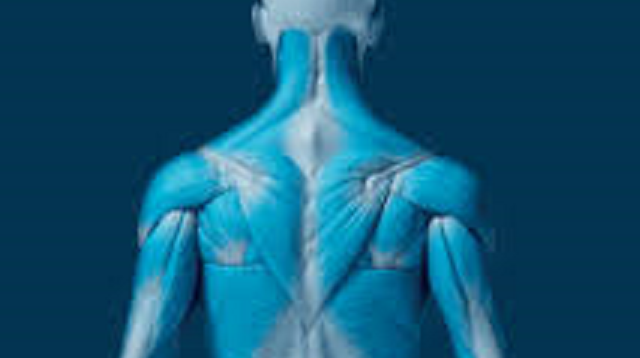Strengthen you midback to improve your posture and decrease shoulder injuries.
The shoulder is an intricate system composed of several joints and numerous muscles. The shoulder joints and muscles work in synergy to provide a wide range of motion in multiple planes.
In medical terminology the shoulder blade is named the scapula. Scapula retraction occurs when the inner edges of the shoulder blades are pulled toward the spine. Back muscles which attach the spine to the shoulder blade execute this motion. These muscles are located in the midback and are known as the scapula retractors.
Strengthening the scapular retractors increases shoulder function, improves posture and decreases the risk of injury. The scapular retractors consist of the rhomboid major, rhomboid minor, and the middle and lower portions of the trapezius muscle. These muscles contract to retract the shoulder blades
Most non-traumatic shoulder injuries are due to a strength imbalance between the muscles which pull the shoulder forward and the muscles which pull the shoulder backwards. The pectoralis major, pec minor, anterior deltoid, subscapularis, teres major and latissimus dorsi attach to the anterior shoulder. These muscles contract concentrically to rotate the upper arm forward.
The supraspinatus, infraspinatus and teres minor muscles originate on the shoulder blade and attach to the upper arm. When contracted concentrically they rotate the shoulder backwards. Due to size and positioning the posterior muscles are at a biomechanical disadvantage. They are often overpowered and inhibited by the larger anterior shoulder muscles.
Strength imbalances can become so great that the shoulders “roll” forward into poor posture and the scapulas are protracted away from the spine.
Shoulder strength imbalances are a precursor to injury and painful overuse conditions. Bicipital tendinopathy, rotator cuff tendinopathy, shoulder impingement syndrome, subacromial bursitis, shoulder sprain/strains and thoracic outlet syndrome are serious musculoskeletal conditions which are often caused by this strength imbalance.
Strengthen: Balance your shoulder strength by strengthening the posterior muscles. Perform each exercise with precision and perfect technique.
Rows: In the gym bent-over rows, dumbbell rows and seated pulley rows train the scapula retractors. The middle and lower traps and the rhomboids are developed with rows. These basic back lifting exercises are essential for shoulder injury prevention.
Technique: Flawless technique is vital. Emphasize scapular retraction. Start your rowing exercises by first pulling the shoulder blades together. Squeeze your blades toward the spine and maintain that position when pulling the elbows back.
Return to the starting position by first straightening the elbows then releasing the scapular retraction. This precise pattern of movement accentuates development of the scapular retractor muscles.
Chins and pulldowns: These classic exercises develop the latissimus dorsi muscle which is an internal rotator of the shoulder. To train the scapular retractors to their fullest during chins-ups, pull-ups and pulldowns start the exercise by squeezing the scapulas together.
Maintain scapular retraction throughout the entire movement. This strict technique ensures that the muscles which retract the scapulas are working in harmony with the other muscles.
Olympic lifts: Execute cleans and snatches to strengthen the scapular retractors. Olympic lifts require the middle back muscles to work in unison with the surrounding muscles to raise the weight. Implementation of Olympic lifts develops strength in a balanced manner.
Kettlebells: Functional kettlebell training targets the scapular retractor muscles. Multi-joint kettlebell exercises train the entire posterior chain of muscles as one unit. Learn the correct form of kettlebell exercises from a qualified training to maximize your benefits.
Stand up straight with your spine against the sharp edge of a wall’s corner. Maintain your chin parallel to the floor, by not tilting you head up or down, and place the back of your head against the corner.
Without shrugging, squeeze the inside bottom corners of your shoulder blades together. Raise you ribcage and stick your chest forward while keeping your back against the wall. Hold this contracted position for two to six seconds then relax. Perform ten reps at the end of your back training sessions.
Isometric scapular retractors can be performed while taking a break at your computer workstation or right before going to bed. This simple exercise is ideal for developing stability, strength and endurance in the shoulders and middle back.
Reverse Flyes: Target the posterior aspect of the deltoid muscles with reverse dumbbell flyes and reverse machine flyes. Perform these exercises after your rows, chins and Olympic lifts. Developing the posterior aspect of the deltoid muscles safeguards against unbalanced deltoid strength.
Reverse pitch: Develop stability, strength and coordination in the posterior shoulder with the reverse pitch exercise. Target the rotator cuff, scapular retractors and posterior deltoid with one exercise by performing a backwards throwing motion. Utilize the reverse pitch to train all the posterior shoulder muscles in a concentric manner.
Utilize very light weights and high repetitions with a cable or resistance band connected to a structure at ankle height. Stand up straight, grip the handle with your right arm hanging straight down and your palm facing the front of your left thigh.
Retract your shoulder blades together. Pull your right shoulder back until your upper arm is parallel to the floor and slightly behind your shoulder. Your elbow is bent to ninety degrees and your palm is facing the floor.
Finish by rotating your shoulder backwards until your palm faces forward. Return to the starting position in the exact opposite manner. Execute this learned motion after completing your back and shoulder training but before performing the isometric scapular retraction.
Using perfect technique is a must when doing the reverse pitch. Concentrate on your form. Practice with no resistance until your technique is flawless. Once this is achieved begin using very light resistance.
Stretching: Increase flexibility in the chest to increase shoulder motion and improve your posture. Stretching the anterior shoulder muscles works in unison with strengthening the posterior shoulder muscles to decrease the possibility of acquiring a shoulder overuse condition.
Stretch the chest muscles in a variety of manners and angles for optimum results. Utilize a foam roller, a fitball or doorframe for maximum productivity.
Conclusion: Strengthening the muscles that retract the scapula with perfect exercise technique yields the best results. Start with very light weights and learn the motions before increasing the resistance. Improve your posture and eliminate strength imbalances by strengthening the posterior shoulders and stretching the chest muscles.
Dr Donald A Ozello DC of Championship Chiropractic in Las Vegas, NV
Web Site: http://www.championshipchiropractic.com/
Blog: https://www.championshipchiropractic.com/wordpress/
YouTube: https://www.youtube.com/user/drdozellodc/videos
Twitter: https://twitter.com/drdozellodc
Facebook: https://www.facebook.com/Championship-Chiropractic-280141628688300/
LinkedIn: https://www.linkedin.com/in/dr-donald-a-ozello-dc-716b3233
“Running: Maximize Performance & Minimize Injuries” https://www.amazon.com/Running-Performance-Chiropractors-Minimizing-Potential/dp/1493618741
**Disclaimer: Always consult a medical professional before beginning an exercise program. Always work within your capabilities. Never perform an exercise that elicits or increases pain or symptoms. Reading this article and viewing the linked videos does not take the place of seeing a medical professional. Please visit a medical professional for evaluation, diagnosis & treatment.

